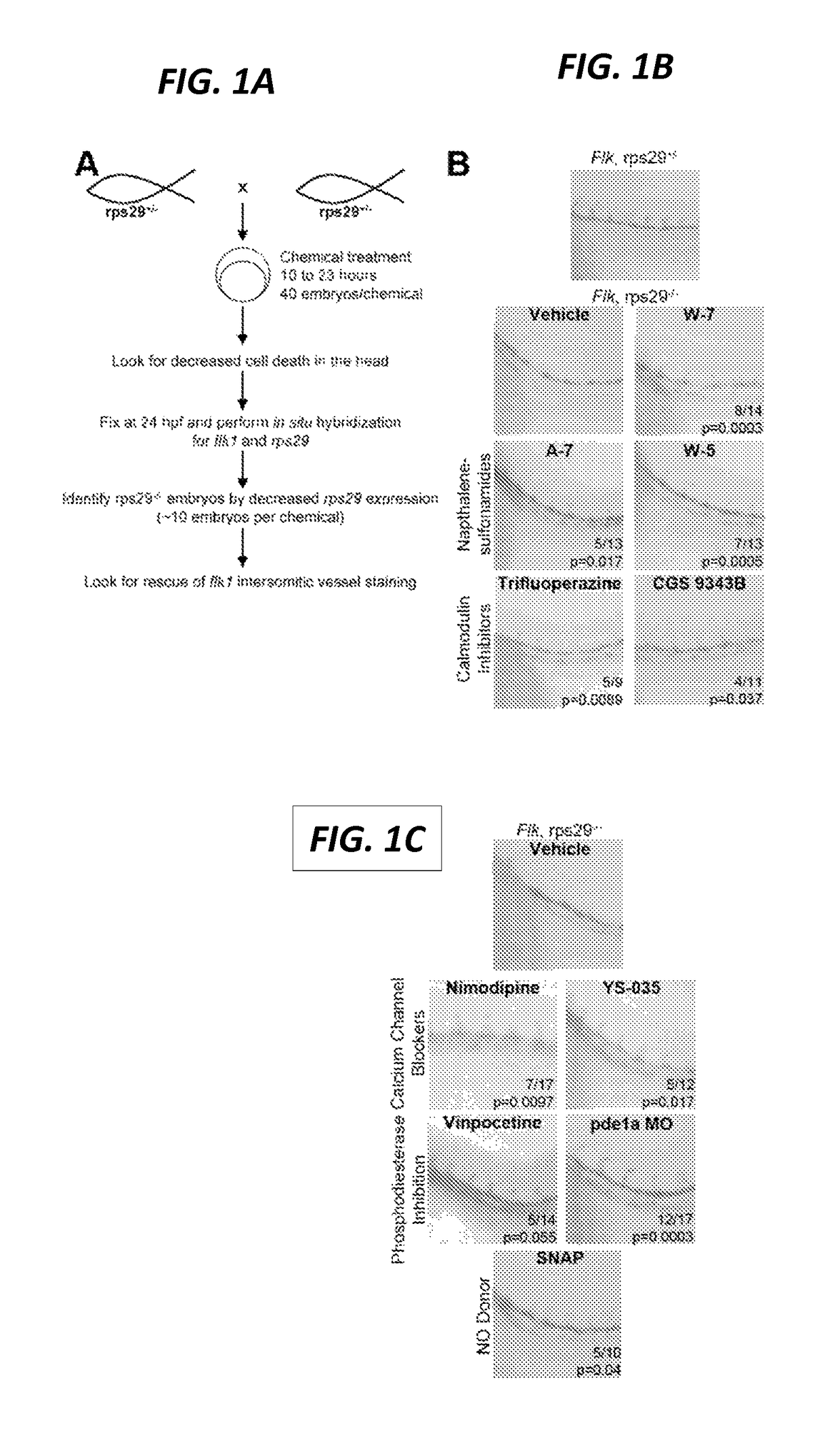Calmodulin inhibitors for the treatment of ribosomal disorders and ribosomapathies
a calmodulin inhibitor and ribosomal technology, applied in the direction of antimycotics, amide active ingredients, anticyclic compound active ingredients, etc., can solve the problems that the current treatment options for diseases associated with a ribosomal disorder or a ribosomalopathy are far from optimal, and achieve the effect of increasing the number of cd71+ erythroid cells in the subject and increasing hemoglobin levels
- Summary
- Abstract
- Description
- Claims
- Application Information
AI Technical Summary
Benefits of technology
Problems solved by technology
Method used
Image
Examples
example 1
[0258]Ribosomal protein mutations are common in patients with Diamond Blackfan anemia (DBA), who have red cell aplasia and craniofacial abnormalities. The inventors have previously characterized a zebrafish mutant in rps29, a ribosomal protein in the small subunit. Rps29− / − embryos have morphological defects in the head, as well as decreased hematopoietic stem cells, hemoglobin, and staining of endothelial markers. Consistent with other models of DBA, knockdown of p53 near completely rescues the rps29 mutant phenotype. To identify chemicals that could rescue the rps29 mutant phenotype, the inventors performed an in vivo chemical screen. Calmodulin inhibitors were found to rescue morphological, endothelial, and hemoglobin phenotypes.
[0259]Zebrafish RPS29 Mutants have p53-dependent Hematopoietic Phenotypes
[0260]The inventors zebrafish work has focused on the rps29 mutant (Amsterdam et al., 2004). The inventors have previously reported that Rps29 mutant embryos was initially have hemat...
example 2
[0265]Inhibition of Calmodulin Dependent Phosphodiesterase Rescues Vasculature
[0266]Other compounds identified in the screen targeted calmodulin-related pathways (FIG. 1C). Ca2+ channel blockers Nimodipine and YS-035 both rescued the vasculature defect. Many enzymes in the cell require calmodulin, including calmodulin-dependent kinases (CaMKs, myosin light chain kinase) and phosphatases (calcineurin) and other enzymes (including phosphodiesterase1) (Chin and Means, 2000; Inagaki et al., 1986). Vinpocetine, an inhibitor of calmodulin-dependent phosphodiesterasel (pde1), was a hit in the screen. Next, the inventors to assess if pde1 was the relevant enzyme being targeted by the calmodulin inhibitors. To confirm pde1 as the relevant target, the inventors injected a morpholino targeting pde1a into rps29− / − embryos. Pde1a knockdown also rescued the vasculature (FIG. 1C). Phosphodiesterases can negatively regulate nitric oxide (NO) signaling, as they degrade cGMP, a mediator of the NO sig...
example 3
[0267]Calmodulin Inhibitor Rescues Head and Hemoglobin Defects in rps29− / − Embryos
[0268]Of all the chemicals screened, only one rescued the morphology of the rps29− / − head, A-3 (FIG. 2A). A-3 is a structural derivative of W-7 (FIG. 2B) and known calmodulin inhibitor. Treatment with A-3 can also rescue hemoglobin levels in the rps29 mutant embryos (FIG. 2C). A-3 treatment did not rescue the vasculature (data not shown), but has previously been shown a less effective inhibitor of calmodulin dependent PDE1 than other calmodulin-dependent enzymes (Inagaki et al., 1986). This suggests that the mechanism by which A-3 rescues the head and red blood cell defects is independent of pde1.
[0269]Calmodulin Inhibition Attenuates p21 Protein upon RPS19 Knockdown
[0270]The inventors next tested the effect of calmodulin inhibitors in A549 cells, where p53 is not mutated and is induced upon ribosomal protein knockdown (Fumagalli et al., 2009). A549 cells were infected with control or RPS19 shRNA and t...
PUM
| Property | Measurement | Unit |
|---|---|---|
| pH | aaaaa | aaaaa |
| concentration | aaaaa | aaaaa |
| half life | aaaaa | aaaaa |
Abstract
Description
Claims
Application Information
 Login to View More
Login to View More - R&D Engineer
- R&D Manager
- IP Professional
- Industry Leading Data Capabilities
- Powerful AI technology
- Patent DNA Extraction
Browse by: Latest US Patents, China's latest patents, Technical Efficacy Thesaurus, Application Domain, Technology Topic, Popular Technical Reports.
© 2024 PatSnap. All rights reserved.Legal|Privacy policy|Modern Slavery Act Transparency Statement|Sitemap|About US| Contact US: help@patsnap.com










